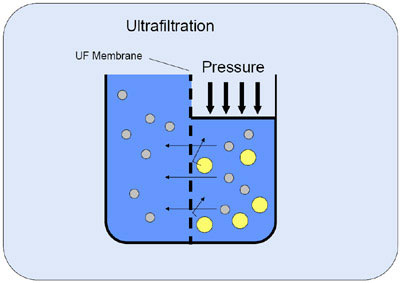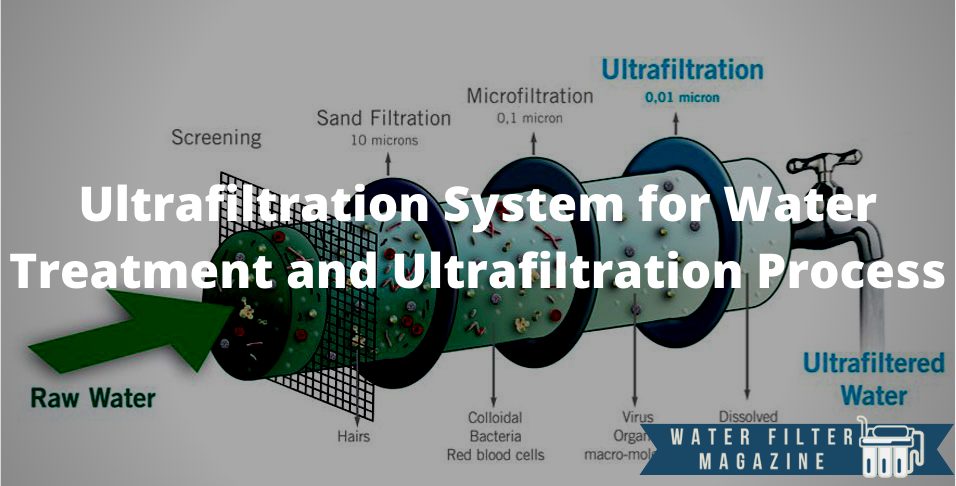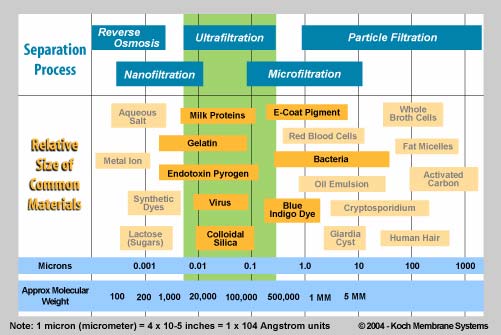Ultrafiltration is a water treatment process during which water is forced through a semipermeable membrane to filter out suspended solids of high molecular weight. Ultrafiltration can remove salts, most organic molecules, and some viruses while maintaining the essential salts in water. Unlike some other popular water treatment systems, ultrafiltration does not generate wastewater and is eco-friendly. Easy installation and low maintenance costs also make ultrafiltration a popular purification system.
What is an Ultrafiltration System?
Ultrafiltration is a water treatment system that is characterized by semi-porous membranes that are able to filter out suspended solids as well as microbial organisms like bacteria, protozoa, and some viruses. However, ultrafiltration systems are not able to remove dissolved substances, for instance, minerals. The ability to remove such particles and all viruses differentiate ultrafiltration systems with other superior systems like nanofiltration and reverse osmosis that can eliminate even minerals such that the resultant treated water is pure.
The pore size of the membranes of an ultrafiltration system ranges between 0.1 and 0.01 microns. With this system, water is applied under pressure such that any particle that is bigger than the pore size of the membrane remains on the inside part of the membrane (retentate), and only water and the dissolved solids are able to pass through. Ultrafiltration is therefore widely used for the removal of suspended solids and any solutes with a higher molecular weight.
The diagram below shows the different water filtration systems and what they are capable of removing in relation to ultrafiltration.
Figure 1: Comparison of the ultrafiltration system and other water filtration processes and their effectiveness (Kumar, 2016)
What are the Unique Sides of an Ultrafiltration System?
Ultrafiltration systems have several advantages over other conventional water and wastewater treatment systems. These include the following:
- Quality: Ultrafiltration systems offer high-quality drinking water that is devoid of impurities and most disease-causing organisms like bacteria, protozoa, and some viruses.
- Eco-friendliness: Ultrafiltration systems can be totally free of or use minimal chemicals during the treatment process. Chemicals can be a source of secondary pollution for example the use of ozonation in water with bromine can form bromate which can be carcinogenic.
- Ease of use: Ultrafiltration systems are easy to install and operate and can even be used in households, unlike other systems.
- Efficiency: Ultrafiltration systems have a high efficiency of the filtration process. This is an advantage because they eliminate all suspended solids and colloids as well as other microbes from the water.
- Re-usable product: Most traditional wastewater treatment methods cannot fully and safely treat wastewater such that it can be safely reused. In contrast, UF systems offer the opportunity for the safe reuse of treated wastewater.
- Energy savings: Ultrafiltration systems are characterized by lower energy costs compared to nanofiltration and reverse osmosis.
- Automatic: There are minimal manual actions when using ultrafiltration systems compared to other systems.
- Compact: The space required for the waterworks under the UF system is significantly less than under the conventional water treatment works.
What are the Advantages of the Ultrafiltration System for Reverse Osmosis?
The ultrafiltration system has several advantages compared to reverse osmosis. These include:
- Retention of essential minerals: The UF system does not remove some minerals essential for human health like calcium, magnesium, and sodium, etc. which the reverse osmosis system removes. Therefore, the water from RO is devoid of some of those essential salts and minerals.
- Cost: The cost of pretreatment with UF is less than for RO. Due to the size of the pores in the membranes (UF and RO) being different (between 0.1 and 0.01 microns for UF and 0.0001 microns for RO), it means that even the finer material that passes through the UF pores will be retained by the RO system. For the RO to be effective, the water has to be pretreated at least to UF level so as to eliminate the bigger particles thus making the process expensive due to the pre-treatment cost before the water gets to the RO system.
- Water pressure level: The UF runs on low water pressure whereas RO needs a booster pump to enable water to move. This means that the UF system is able to operate at the natural pressure which translates to zero energy cost to the users/operators compared to the RO system where pumping costs have to be met to enable the booster pump to move water within the system as the water cannot move without being pumped.
- Wastewater production: The UF does not waste water compared to the RO system. The UF system does not create wastewater compared to the RO during the filtration process. The process of RO uses the principle of cross-flow filtration such that one pathway of pure water goes for storage (about 25%) whereas about 75% of the water containing dissolved salts, minerals, and other impurities is disposed of. As such the bulky of the water in the RO system becomes wastewater that is not used. This basically means that UF systems are more environmentally friendly and conserve water especially in the context of the increasing phenomenon of water scarcity.
- Installation: The UF system is a simpler system to install as the inlet of the system is generally installed on the water supply of the user and the treated water is just obtained/sourced on-demand. With simple tools like a drill, screwdriver, and wrench, one can install an ultrafiltration system without requesting a call out for a plumber. In contrast, for the RO there are a couple of installations that need to be done. These include the connection to the water supply, the connection to the drain (for the disposal of wastewater), and the connection to the storage.
- Storage requirements: The UF system does not require storage as water is just sourced as and when it’s needed for use. However, for the RO system, the water comes out very slowly and needs to be stored for future use by the consumer(s).
- Potential for bacterial contamination in storage: Whereas the UF does not have a storage tank, the storage tank of the RO can be a source of bacterial contamination if it is not sanitized regularly. As such the entire RO system needs to be sanitized regularly to prevent this bacterial contamination.
How does the Ultrafiltration System Work?
 Despite the different types of ultrafiltration systems, the mechanism in which they work is the same. The ultrafiltration system works through the principle of letting water pass through the pores of a membrane such that the larger particles in the untreated water cannot pass through the pores of the membrane. The water that passes through becomes the treated water at the outlet whereas the accumulated constituents that cannot pass through the pores get disposed of. Basically suspended solids, as well as those solutes with a higher molecular weight, will get retained (in the retentate) whilst water, dissolved solids, and solutes of lower molecular weight will pass through the pores of the membrane system (in the permeate) towards the faucet where the water can either be ready for usage or can be fed into a reverse osmosis system for further treatment. To treat water using this system, one needs the inlet connection, the membrane system, and the faucet that acts as the outlet of the treated water.
Despite the different types of ultrafiltration systems, the mechanism in which they work is the same. The ultrafiltration system works through the principle of letting water pass through the pores of a membrane such that the larger particles in the untreated water cannot pass through the pores of the membrane. The water that passes through becomes the treated water at the outlet whereas the accumulated constituents that cannot pass through the pores get disposed of. Basically suspended solids, as well as those solutes with a higher molecular weight, will get retained (in the retentate) whilst water, dissolved solids, and solutes of lower molecular weight will pass through the pores of the membrane system (in the permeate) towards the faucet where the water can either be ready for usage or can be fed into a reverse osmosis system for further treatment. To treat water using this system, one needs the inlet connection, the membrane system, and the faucet that acts as the outlet of the treated water.
What are the Types of Ultrafiltration Systems?
The types of ultrafiltration systems include the point-of-use ultrafiltration system and the point-of-entry ultrafiltration system. The point-of-use UF system is installed at the point-of-use, normally at a single tap such that the membrane is either under the kitchen tap or on the counter for treating high-quality water at that point; for instance, for drinking or cooking. In contrast, the point-of-entry UF system is installed at the entry point of the water into the whole house/property and filters the water that does not need to be treated to fine levels for all the household uses. This covers all the household use that doesn’t need fine water (like drinking) but targets aspects like the removal of colloidal material (in suspension) and tannin (organic material).
Point-of-use Ultrafiltration System
As a result of the fact that the UF system is installed at a specific point of use, the importance of treating water to a finer level is deemed to be at that point which is normally the kitchen tap. The level of treatment required is finer with a target of attaining about 0.025 microns. This system should stay longer than the point-of-entry system because it only filters a small volume of water (at any given time) that is dedicated for specific uses.
Point-of-entry Ultrafiltration System
The target of a point-of-entry ultrafiltration system is to treat the water to a quality that is better than at the entry point through the removal of the excess residual material but might not need a fine water quality like for drinking or cooking purposes. This system therefore might seek to attain above 0.025 microns since this is for a wide variety of household use which includes bathing, laundry, and washing dishes which do not necessarily need that fine quality of water. The lifespan of the point-of-entry ultrafiltration system will be shorter than the point-of-use ultrafiltration system because this system filters all the water that gets used in a specific household at any given time.
What are the Useful Ultrafiltration Water Filters?
There are a number of UF systems that work using different mechanisms.
- Hollow Fibre Ultrafiltration Systems: Hollow fibre ultrafiltration is a UF system that is used where there are moderate suspended solids in the water to be treated. The membrane system is characterized by hundreds of tubes inside it that resemble a pipe with many straws inside. The straw-like structures are membranes with pores on their walls. When water is introduced through the “straw-like tubes”, suspended solids and other microbes like bacteria are retained inside the tubes as they cannot pass through the pores such that only water, dissolved solids, and some viruses can pass through.
- Spirals Ultrafiltration Systems: Spirals are a UF system that is characterized by spiral-wound elements that can be used where there are relatively low suspended solids.
- Tubular Ultrafiltration Systems: Tubular UF systems are ideally used in environments where there are high levels of suspended solids. Water is introduced into the membrane tubes under pressure such that the pressure forces the water through the membrane wall whilst the suspended solids are retained in the tube as they cannot pass through the membrane pores. The suspended solids exit the membrane tube on the other end where they are collected for disposal. This UF system is common in the treatment of wastewater and can be an ideal pretreatment for RO.
- Plate and Frame Ultrafiltration Systems: The plate and frame UF system utilize membranes that get placed on top of plate-like structures that are bolted together by a frame-like support structure. These systems are not characterized by feed spacers which minimize the disadvantage of fouling that is common with other ultrafiltration systems. They also have the advantage of being able to handle water with high suspended solids levels.
How to Install an Ultrafiltration System?
Domestic Use installation: Ultrafiltration systems are quite simple to install. One needs a wrench, screwdriver, and a drill kit to install an ultrafiltration system and just needs to decide where the system will be installed i.e. whether it will be a point-of-entry or point-of-use system although the principle is the same. For the point-of-use system, one needs to connect the inlet of the UF membrane system to the cold water system under the sink via a T-fitting adaptor using a wrench such that only the water needed for the UF system gets diverted to the system. Otherwise, the rest of the cold water flows to the kitchen cold water faucet. One should not connect the UF system to the hot water system as that will damage it. The pipe will run through the membrane system. One needs to drill a hole on the kitchen counter for firmly installing a faucet that is used as an outlet for the UF-treated water.
When to Use an Ultrafiltration System?
The ultrafiltration system has wide applications in the treatment of water, wastewater, and other fluids or liquids. This system is mainly used under some of the circumstances described below. Ultrafiltration systems are suitable where the fluid, especially water being treated, has high levels of suspended solids that need to be retained and disposed of. The pore sizes of the membrane walls range between 0.1 and 0.01 microns and as such, they are able to eliminate suspended solids for example from the water and wastewater. Ultrafiltration systems are also ideally suitable in instances where the fluid is to be treated as a higher molecular weight. Such fluids are not able to pass through the pores of the membrane and get retained in the retentate for disposal.
In instances where a wide range of microbial organisms and other constituents need to be removed for example bacteria, some viruses, fat, enzymes, and proteins, etc, it is also feasible to use ultrafiltration systems. Furthermore, in cases where there is a need to pretreat water before reverse osmosis, for example during wastewater treatment or desalination ultrafiltration systems become suitable. This is because of the ultrafiltration system’s capability of removing the suspended solids before treating the water using reverse osmosis to remove dissolved solids and the constituents with a lower molecular weight. In the food and beverage industries, for example in the dairy industry and beer breweries, ultrafiltration systems are widely used because of their ability to remove suspended solids. Ultrafiltration treatment systems are also used in the health and allied industries for example in dialysis and blood treatments.
Who Invented the Ultrafiltration System?
The brainchild of the ultrafiltration membrane system was a German researcher, Dr. Bechhold. His first membrane was a simple low-pressure cellulose membrane (collodion) which he developed in 1907. This was developed by applying acetic acid to filter paper and he named it an “Ultrafilter” collodin membrane. Since then there have been significant improvements from that membrane by different scientists to come up with the various modern-day types of ultrafiltration systems.
What are the Ultrafiltration System Producers?
Some of the common global Ultrafiltration systems manufacturers include the following:
- Koch Separation Solutions, USA.
- Suez Water Technologies and Solutions, USA.
- Pall Corporation, USA.
- QUA, USA.
- PolyCera Membranes, USA.
- De.mem Pte Ltd, Singapore.
- Novamem GmbH, Switzerland.
- NX Filtration, Netherlands.
- Lenntech, Netherlands.


